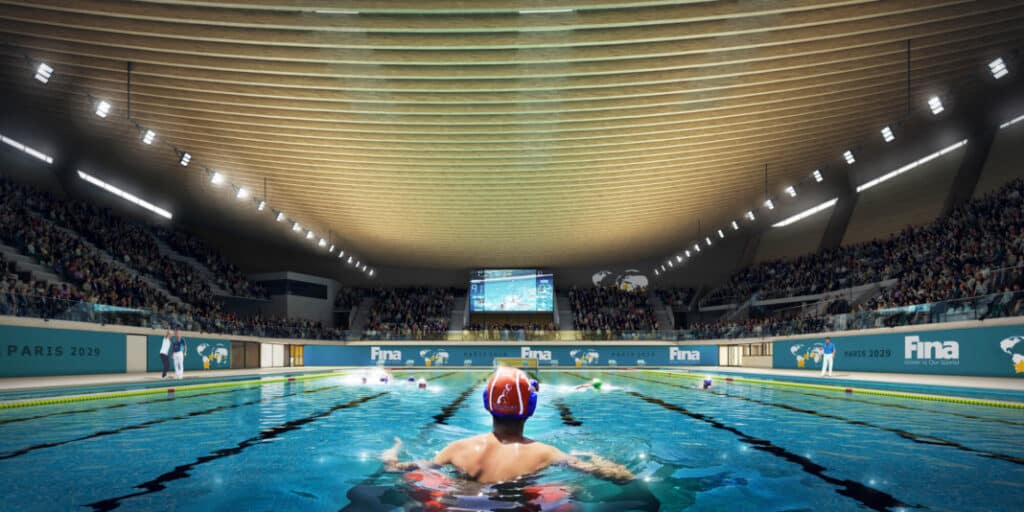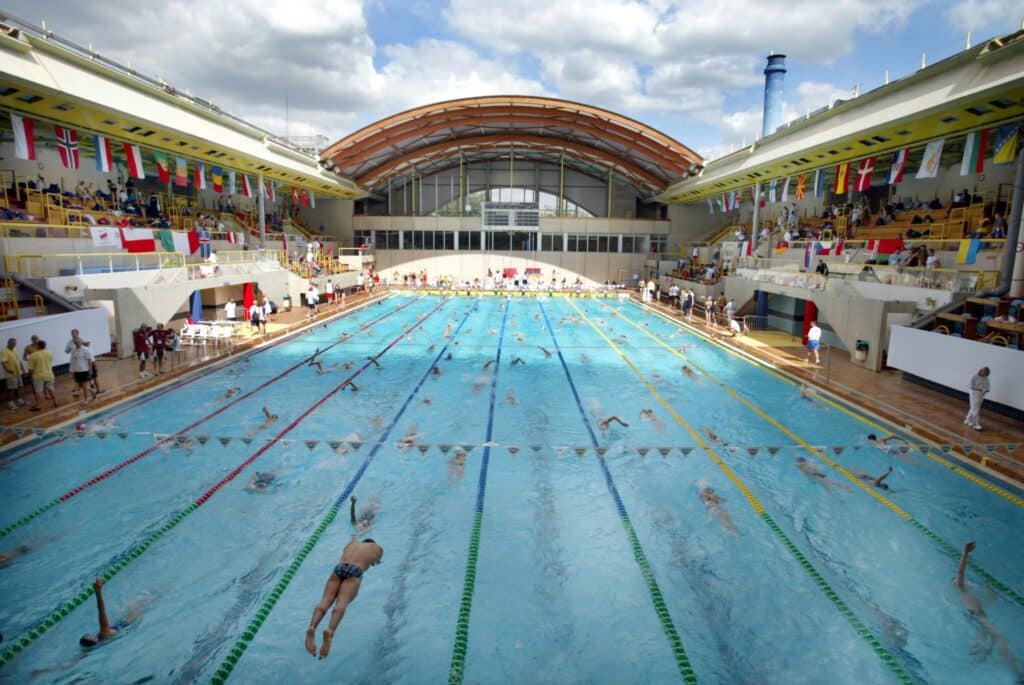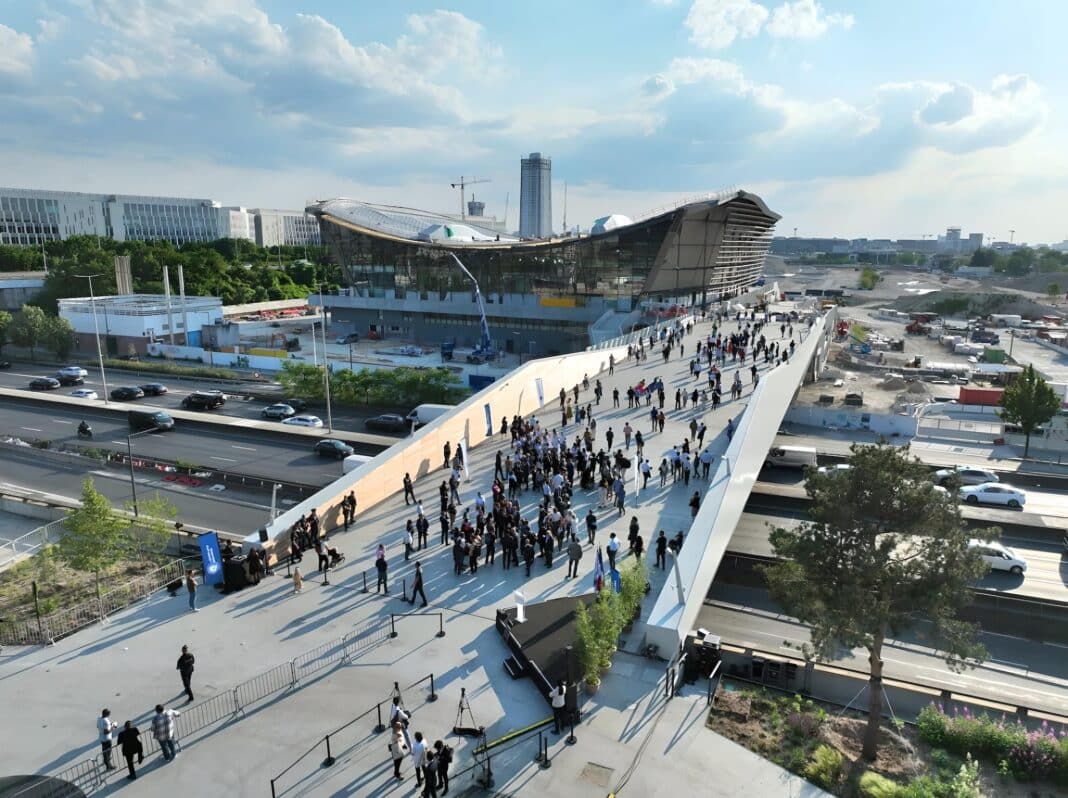Just days before the Opening Cermony, organisers are putting the finishing touches on venues after a decade-long “eco-building boom,” including the new Aquatics Centre, the only permanent sports facility constructed for the Games.
In March, Wood Central reported that the work had now finished on the Athletes Village, where all buildings under eight floors are constructed from wood and glass, and all energy will be sustainably sourced via heat pumps and renewables.
Now, it can reveal that the Aquatics Centre—the main architectural icon for the games, which has been designed Ateliers 2/3/4/ and VenhoevenCS— has been prefabricated several hundreds of miles away from Paris before being assembled piece by piece “like Lego.”
So streamlined and effective is the process, according to Frank Mathis, the president of Mathis, the company manufacturing the timber used in the Centre, that the mill has been preparing “enough components to build a tennis court-sized part of the structure every day.”
The process of assembling the buildings on site is even swifter. “With some of our products,” Mr Mathis said before adding, “we assemble the pieces twice as fast as we fabricate them.” Hangars in and around Paris are waiting to be filled with wood components ready for assembly – which is a sign of the changing face of the French construction industry.
Every game leaves a legacy, and according to Etienne Thobois, the Paris 2024 Olympic Games CEO, “sustainability is this game legacy,” who confirmed that more than 95% of the venues have been upcycled.
Already, this make-do-and-mend approach has helped catapult France’s eco-construction revolution. The French Government is turning to retrofitting and using mass timber in new construction to reduce its emissions by 55% over the next six years.
“While our wood construction industry is not as developed as, say, Austria or Germany,” according to Luc Floissac, an environmental adviser and researcher at Toulouse University, who spoke to Bloomberg, “our use of bio-based materials such as straw for buildings is already ahead of all the other European countries combined.”
The French government has already issued €200 million in subsidies to projects using wood and other biomaterials – with the government now pushing for at least 50% of French timber buildings to be constructed from locally grown PEFC and FSC-certified forests (the Aquatic Centre is targeting 30-40%).
According to a report commissioned by France Bois Forêt in July, timber construction reached €4.6 billion last year, an increase of 14% since 2020. The number of new non-residential buildings rose from 18.3% in 2022 to 16.8% in 2020, and the industry is now targeting 20% to 30% by 2030 – mainly by wresting market share from concrete.

And it’s ramping up its industrial capacities to meet that goal.
“Industrial equipment in France is undersized,” according to Dominique Cottineau, director of the Wood Construction Industry Union (UICB), who also spoke to Bloomberg. “But the trajectory is changing, and we’re going to be building with much more wood than before.”
In July 2020, the Dutch studio VenhoevenCS and its French partner Ateliers 2/3/4/ won the right to design the new Aquatics Centre, which will host artistic swimming, water polo, and diving events.
A pedestrian bridge connecting the Centre to the ‘Stade de France’ (erected in August 2022) makes it “an important investment in the future of Saint-Denis,” one of the most problematic neighbourhoods in France.
The venue’s main hall is topped by a 5,000 sqm glue-laminated timber roof—supplied by Mathis—that spans 89 metres but is only 50 centimetres in diameter. The curved roof is raised at the sides to accommodate the stands while dipping in the middle to reduce the volume of the space, making it more efficient to heat.
“The roof, stretched with wooden beams, magnifies the space thanks to its dynamic curves that make it both intimate and airy,” according to a statement by designers after being commissioned to design the impressive build. “Adapted to open heights and optimal visibility from the stands, this sculpted membrane seems to move and undulate like a living organism.”
All visible structural elements inside the Centre are made from timber, supporting loads of up to 800 tonnes. “By using wood for this monumental structure, the proposal doubles the required minimum percentage of bio-sourced materials,” meeting the organising committees’ sustainability requirements,” they said.
According to Laurie Mériaud, partner at Ateliers 2/3/4/, building with wood has several advantages beyond the practical and aesthetic.
“We wanted to use the least amount of material possible, and wood means we don’t have to use drywall or other fixes used in construction to hide structural elements.
That can give wooden buildings an extra sensual charm, according to Cécilia Gross, partner at VenhoevenCS. “We don’t have to paint it,” she says. “It has warmth, it has colour, and it has a scent. You can smell it when you’re in the pool.”

The roof is also topped with solar panels, making it France’s most significant urban photovoltaic farm.
During the Games, the first floor will accommodate stands for 6,000 people. These stands will be positioned alongside the pool, with a third stand opposite the diving tower.
Following the Games, one of the stands will be removed to reduce the capacity to 2,500. The space where the stand stood will then be used for five-a-side football pitches, which will overlook the main pool.
Both sides of the building will be clad in timber with a sunshade made from a steel structure supporting timber louvres, enclosing walkways containing seating – part of an effort to integrate the building into the surrounding park.

The Georges-Vallerey Pool was revamped ahead of the Games.
One hundred years after the 1924 Paris Olympics, the Georges-Vallery pool, the first dedicated Aquatic Centre used in the Olympic movement, is one of the venues that has finished renovations.
The pool, currently a construction site, proudly displays the Olympic rings – a sight it is no stranger to.
A century ago, the complex counted great exploits in the pool, notably that of the American Johnny Weissmuller, a three-time Olympic medallist who later became Tarzan on the screen.

In addition to these feats, it was avant-garde.
It was the first Olympic pool in France with a 50-meter pool, which was defined by separating the pool into several lines to create lanes.
However, due to its limited seating capacity, the pool will not host competitive swimming events at the upcoming games. Instead, it will serve as a training site, assisting Olympians in preparing for the games.
Around 50 workers have worked on completing the renovations, with most of the renovation work about the pool and its roof covering, which has been absent since January.
Romain Vault from AIA Life Designers is leading the reconstruction. The previous roof was made of larch wood, which will be replaced by Douglas fir from forests in the Vosges and Jura.
“Through this renovation project, there is also a powerful environmental and social ambition,” explains Flavie Anet, project manager for the operation within the steering and expertise division of the Paris City Council’s Youth and Sports Department.

The timber from the old framework will be used to make furniture and signage for the renovated pool. The city of Paris has donated excess timber to the Extramuros Association, a Parisian volunteer association that recycles building materials.
On the other hand, Parisians will have to wait until the end of the Olympic Games, in March 2025, to swim in the pool and enjoy the good weather and the sun on summer afternoons, thanks to the future new opening roof.
Will Paris 2024 leave a tree-growing legacy?
According to Bloomberg, France is covered in 17 million hectares (66,000 square miles) of wood, with three-quarters on private land, broken up into small parcels.
“There’s a myriad of very small owners, and it’s hard to figure out who owns what. Some people don’t even realise that they have forests,” according to Jérôme Martinez, head of the Bois de France certification label, which guarantees that wood is sourced and processed in the country. “It’s a real stumbling block.”
French wood is — like all commercial timber — also vulnerable to geopolitical shocks that make its price unstable.
According to Frank Mathis, the war in Ukraine forced him to “hunt down wood truckload by truckload to keep the woodyard running” as supplies from the former Soviet Union dwindled and other European producers diverted their timber across the Atlantic for higher prices.
- Click on Wood Central’s special feature for more information about the Paris Olympic Games and its timber-based venues.






